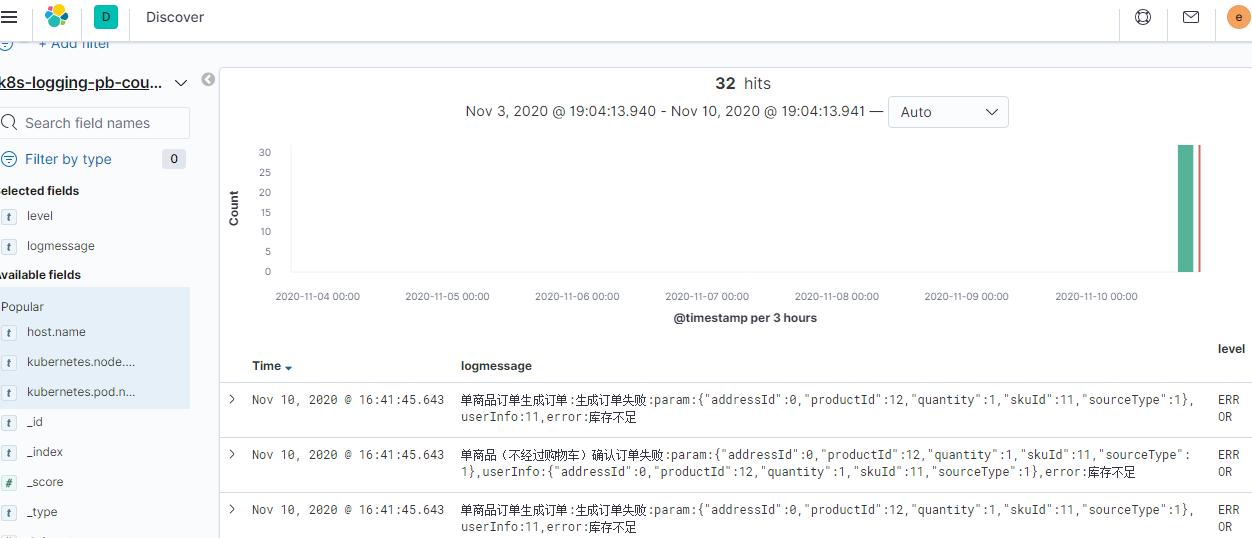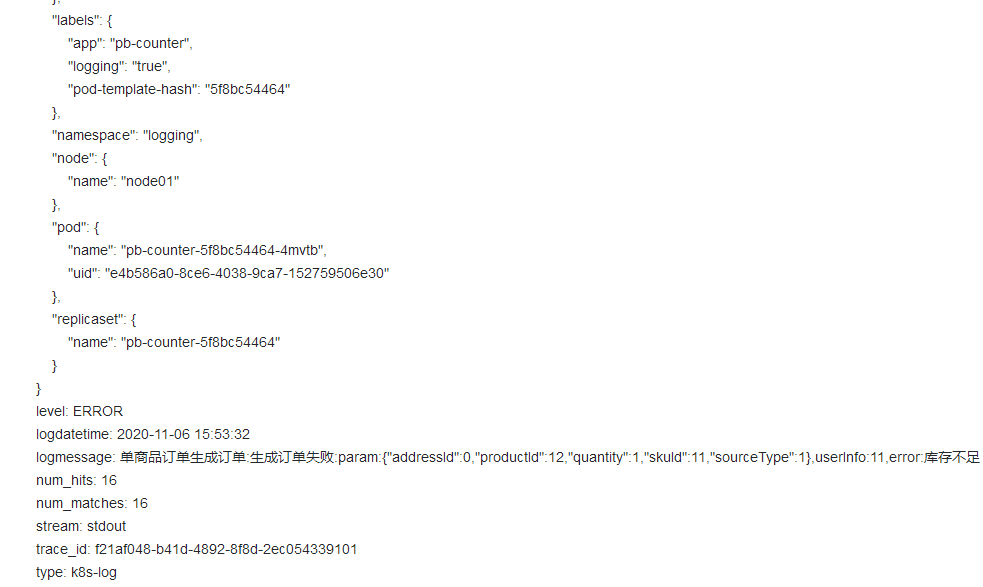Kubernetes EFK收集日志
一、环境准备
-
Kubernetes:1.19.2
-
Elasticsearch:外部Elasticsearch,版本7.8
-
Kibana:外部Kibana,版本7.8
-
filebeat: elastic/filebeat:7.8.0
-
logstash: elastic/logstash:7.8.0
-
redis: redis:5.0.10-alpine
二、日志目录
K8S中的日志目录有3种:
- /var/lib/docker/containers
- /var/log/containers
- /var/log/pods
它们之间的联系
- 当Docker 作为 k8s 容器运行时,容器日志的落盘将由 docker 来完成,保存在/var/lib/docker/containers/$CONTAINERID 目录下
- Kubelet 会在 /var/log/pods 和 /var/log/containers 下建立软链接,指向 /var/lib/docker/containers/CONTAINERID 该目录下的容器日志文件
- 当Containerd 作为 k8s 容器运行时, 容器日志的落盘由 Kubelet 来完成,保存至 /var/log/pods/$CONTAINER_NAME 目录下,同时在 /var/log/containers 目录下创建软链接,指向日志文件
/var/log/containers目录中日志名称:podName_NameSpace_ContainerName_ContainerID
三、创建External service
用于连接K8s外部的elasticsearch
先创建一个public-serivce的namespace
kubectl create ns public-service
es-svc-external.yaml
apiVersion: v1
kind: Service
metadata:
name: elaticsearch-svc-external
namespace: public-service
labels:
app: elaticsearch-svc-external
spec:
ports:
- port: 9200
name: elaticsearch-svc-external
protocol: TCP
type: ClusterIP
创建elasticsearch的endpoint
es-ep.yaml
apiVersion: v1
kind: Endpoints
metadata:
labels:
app: elaticsearch-svc-external
name: elaticsearch-svc-external
namespace: public-service
subsets:
- addresses:
- ip: 192.168.100.144
ports:
- name: elaticsearch-svc-external
port: 9200
protocol: TCP
查看
kubectl get svc -n public-service NAME TYPE CLUSTER-IP EXTERNAL-IP PORT(S) AGE elaticsearch-svc-external ClusterIP 10.109.66.130 <none> 9200/TCP 43h kubectl get ep -n public-service NAME ENDPOINTS AGE elaticsearch-svc-external 192.168.100.144:9200 43h
测试,启动一个带curl的pod测试能否获取elasticsearch的信息
这个elasticsearch有安全认证
curl -XGET --user elastic:elastic http://elaticsearch-svc-external.public-service:9200/_cluster/health?pretty=true
{
"cluster_name" : "es-cluster",
"status" : "yellow",
"timed_out" : false,
"number_of_nodes" : 1,
"number_of_data_nodes" : 1,
"active_primary_shards" : 11,
"active_shards" : 11,
"relocating_shards" : 0,
"initializing_shards" : 0,
"unassigned_shards" : 3,
"delayed_unassigned_shards" : 0,
"number_of_pending_tasks" : 0,
"number_of_in_flight_fetch" : 0,
"task_max_waiting_in_queue_millis" : 0,
"active_shards_percent_as_number" : 78.57142857142857
}
redis.yaml
apiVersion: v1
kind: Service
metadata:
name: redis-svc
namespace: public-service
labels:
app: redis
spec:
selector:
app: redis-single
ports:
- protocol: TCP
port: 6379
targetPort: 6379
---
apiVersion: apps/v1
kind: Deployment
metadata:
annotations:
deployment.kubernetes.io/revision: "18"
labels:
app: redis
name: redis
namespace: public-service
spec:
replicas: 1
revisionHistoryLimit: 10
selector:
matchLabels:
app: redis-single
strategy:
rollingUpdate:
maxSurge: 1
maxUnavailable: 0
type: RollingUpdate
template:
metadata:
labels:
app: redis-single
spec:
nodeSelector:
logging: "true"
affinity:
podAntiAffinity:
preferredDuringSchedulingIgnoredDuringExecution:
- podAffinityTerm:
labelSelector:
matchExpressions:
- key: app
operator: In
values:
- redis-single
topologyKey: kubernetes.io/hostname
weight: 100
containers:
- command:
- redis-server
- /usr/local/etc/redis.conf
env:
- name: TZ
value: Asia/Shanghai
- name: LANG
value: C.UTF-8
image: redis:5.0.10-alpine
imagePullPolicy: IfNotPresent
lifecycle: {}
livenessProbe:
failureThreshold: 2
initialDelaySeconds: 10
periodSeconds: 10
successThreshold: 1
tcpSocket:
port: 6379
timeoutSeconds: 2
name: redis
ports:
- containerPort: 6379
name: redis-port
protocol: TCP
readinessProbe:
failureThreshold: 2
initialDelaySeconds: 10
periodSeconds: 10
successThreshold: 1
tcpSocket:
port: 6379
timeoutSeconds: 2
resources:
limits:
cpu: 100m
memory: 100Mi
requests:
cpu: 10m
memory: 10Mi
volumeMounts:
- mountPath: /usr/share/zoneinfo/Asia/Shanghai
name: tz-config
- mountPath: /etc/localtime
name: tz-config
- mountPath: /usr/local/etc/
name: redis-conf
dnsPolicy: ClusterFirst
restartPolicy: Always
schedulerName: default-scheduler
securityContext: {}
terminationGracePeriodSeconds: 30
tolerations:
- effect: NoExecute
key: node.kubernetes.io/unreachable
operator: Exists
tolerationSeconds: 30
- effect: NoExecute
key: node.kubernetes.io/not-ready
operator: Exists
tolerationSeconds: 30
volumes:
- hostPath:
path: /usr/share/zoneinfo/Asia/Shanghai
type: ""
name: tz-config
- configMap:
name: redis-conf
name: redis-conf
- nodeSelector 选择一个节点部署
redis.conf
protected-mode no port 6379 tcp-backlog 511 timeout 0 tcp-keepalive 300 #daemonize yes supervised no loglevel notice logfile "/data/redis.log" databases 16 always-show-logo yes save 900 1 save 300 10 save 60 10000 stop-writes-on-bgsave-error yes rdbcompression yes rdbchecksum yes dir "/data" slave-serve-stale-data yes slave-read-only yes repl-diskless-sync no repl-diskless-sync-delay 5 repl-disable-tcp-nodelay no slave-priority 100 lazyfree-lazy-eviction no lazyfree-lazy-expire no lazyfree-lazy-server-del no slave-lazy-flush no appendonly yes appendfilename "appendonly.aof" appendfsync everysec no-appendfsync-on-rewrite no auto-aof-rewrite-percentage 100 auto-aof-rewrite-min-size 1gb aof-load-truncated yes aof-use-rdb-preamble no lua-time-limit 5000 slowlog-log-slower-than 10000 slowlog-max-len 128 latency-monitor-threshold 0 notify-keyspace-events "xE" hash-max-ziplist-entries 512 hash-max-ziplist-value 64 list-max-ziplist-size -2 list-compress-depth 0 set-max-intset-entries 512 zset-max-ziplist-entries 128 zset-max-ziplist-value 64 hll-sparse-max-bytes 3000 activerehashing yes client-output-buffer-limit normal 0 0 0 client-output-buffer-limit slave 256mb 64mb 60 client-output-buffer-limit pubsub 32mb 8mb 60 hz 10 aof-rewrite-incremental-fsync yes
创建
# kubectl create configmap redis-conf --from-file=redis.conf -n public-service # kubectl create -f redis.yaml # kubectl get pods -n public-service NAME READY STATUS RESTARTS AGE redis-6f45c688f9-j6jsn 1/1 Running 0 130m # kubectl get svc -n public-service | grep redis redis-svc ClusterIP 10.107.68.121 <none> 6379/TCP 137m
filebeat-configmap.yaml
apiVersion: v1
kind: ConfigMap
metadata:
name: filebeat-config
namespace: logging
labels:
k8s-app: filebeat
data:
filebeat.yml: |-
filebeat.inputs:
- type: container
paths:
# 项目以pb开头
- /var/log/containers/pb-*.log
#多行合并
multiline.pattern: '^[0-9]{4}-[0-9]{2}-[0-9]{2}'
multiline.negate: true
multiline.match: after
multiline.timeout: 30
fields:
#自定义字段用于logstash识别k8s输入的日志
service: java-log
processors:
- add_kubernetes_metadata:
#添加k8s描述字段
default_indexers.enabled: true
default_matchers.enabled: true
host: ${NODE_NAME}
matchers:
- logs_path:
logs_path: "/var/log/containers/"
- drop_fields:
#删除的多余字段
fields: ["host", "tags", "ecs", "log", "prospector", "agent", "input", "beat", "offset"]
ignore_missing: true
output.redis:
# 不同namespace下的service联通需要添加其所在的namespace名称
hosts: ["redis-svc.public-service"]
key: "filebeat"
db: 1
timeout: 5
filebeat-rbac.yaml
apiVersion: rbac.authorization.k8s.io/v1
kind: ClusterRoleBinding
metadata:
name: filebeat
subjects:
- kind: ServiceAccount
name: filebeat
namespace: logging
roleRef:
kind: ClusterRole
name: filebeat
apiGroup: rbac.authorization.k8s.io
---
apiVersion: rbac.authorization.k8s.io/v1
kind: ClusterRole
metadata:
name: filebeat
labels:
k8s-app: filebeat
rules:
- apiGroups: [""] # "" indicates the core API group
resources:
- namespaces
- pods
verbs:
- get
- watch
- list
---
apiVersion: v1
kind: ServiceAccount
metadata:
name: filebeat
namespace: logging
labels:
k8s-app: filebeat
filebeat-daemonset.yaml
apiVersion: apps/v1
kind: DaemonSet
metadata:
name: filebeat
namespace: logging
labels:
k8s-app: filebeat
spec:
selector:
matchLabels:
k8s-app: filebeat
template:
metadata:
labels:
k8s-app: filebeat
spec:
serviceAccountName: filebeat
terminationGracePeriodSeconds: 30
nodeSelector:
logging: "true"
containers:
- name: filebeat
image: docker.io/elastic/filebeat:7.8.0
imagePullPolicy: IfNotPresent
# args: [
# "-c", "/etc/filebeat.yml",
# "-e",
# ]
env:
- name: NODE_NAME
valueFrom:
fieldRef:
fieldPath: spec.nodeName
securityContext:
runAsUser: 0
# If using Red Hat OpenShift uncomment this:
#privileged: true
resources:
limits:
memory: 200Mi
requests:
cpu: 100m
memory: 100Mi
volumeMounts:
- name: config
mountPath: /usr/share/filebeat/filebeat.yml
readOnly: true
subPath: filebeat.yml
- name: varlibdockercontainers
mountPath: /var/lib/docker/containers
- name: varlog
mountPath: /var/log
volumes:
- name: config
configMap:
defaultMode: 0640
name: filebeat-config
- name: varlibdockercontainers
hostPath:
path: /var/lib/docker/containers
- name: varlog
hostPath:
path: /var/log
给选择的节点打标签,nodeSelector选择了需要采集日志的节点
# kubectl label node node01 logging=true
创建
# kubectl create ns logging
# kubectl create -f .
查看
# kubectl get pod -n logging | grep filebeat filebeat-z5276 1/1 Running 0 132m # kubectl get cm -n logging | grep filebeat filebeat-config 1 8h
logstash-configmap.yaml
apiVersion: v1
kind: ConfigMap
metadata:
name: logstash-configmap
namespace: logging
data:
logstash.yml: |
http.host: "0.0.0.0"
path.config: /usr/share/logstash/pipeline
logstash.conf: |
# all input will come from filebeat, no local logs
input {
beats {
port => 5044
}
redis {
host => "redis-svc.public-service"
port => "6379"
db => 1
data_type => "list"
key => "filebeat"
type => "k8s-log"
}
}
filter {
if [fields][service] == "java-log" {
grok {
match => { "message" => "%{TIMESTAMP_ISO8601:logdatetime}\s(?:\[\]|\[%{UUID:trace_id}\])\s(?:%{SYSLOG5424SD:thread}|%{SYSLOG5424SD})\s*%{LOGLEVEL:level}\s*%{JAVACLASS:class}\s-\s%{GREEDYDATA:logmessage}"}
remove_field => [ "message" ]
remove_field => [ "agent" ]
remove_field => [ "ecs" ]
remove_field => [ "tags" ]
}
}
}
output {
if [fields][service] == "java-log" {
elasticsearch {
hosts => ["elaticsearch-svc-external.public-service.svc.cluster.local:9200"]
user => elastic
password => elastic
index => "k8s-%{[kubernetes][namespace]}-%{[kubernetes][labels][app]}-%{+YYYY.MM.dd}"
}
#stdout { codec => rubydebug { metadata => true}}
}
}
语法:https://github.com/logstash-plugins/logstash-patterns-core/blob/master/patterns/grok-patterns
测试:http://grokdebug.herokuapp.com/
-
index:自动创建索引,名称为(k8s-namespace-appname)需要在spec.template.namespace / spec.template.labels.app中写明需要的参数
logstash-deployment.yaml
apiVersion: apps/v1
kind: Deployment
metadata:
name: logstash-deployment
namespace: logging
spec:
selector:
matchLabels:
app: logstash
replicas: 1
template:
metadata:
labels:
app: logstash
spec:
nodeSelector:
logging: "true"
containers:
- name: logstash
image: elastic/logstash:7.8.0
imagePullPolicy: IfNotPresent
ports:
- containerPort: 5044
volumeMounts:
- name: config-volume
mountPath: /usr/share/logstash/config
- name: logstash-pipeline-volume
mountPath: /usr/share/logstash/pipeline
volumes:
- name: config-volume
configMap:
name: logstash-configmap
items:
- key: logstash.yml
path: logstash.yml
- name: logstash-pipeline-volume
configMap:
name: logstash-configmap
items:
- key: logstash.conf
path: logstash.conf
创建
# kubectl create -f .
查看
# kubectl get pods -n logging | grep logstash logstash-deployment-bc4d6c6dc-zsmrw 1/1 Running 0 135m
新建一个日志输出pod
counter-deploy.yaml
apiVersion: apps/v1
kind: Deployment
metadata:
name: pb-counter
namespace: logging
labels:
app: pb-counter
logging: "true"
spec:
replicas: 1
selector:
matchLabels:
app: pb-counter
logging: "true"
template:
metadata:
name: pb-counter
namespace: logging
labels:
app: pb-counter
logging: "true"
spec:
nodeSelector:
logging: "true"
containers:
- name: my-counter-test
image: busybox
imagePullPolicy: IfNotPresent
args: [/bin/sh, -c, 'tail -n+1 -f /opt/msg/message.txt']
volumeMounts:
- name: msg
mountPath: /opt/msg
volumes:
- name: msg
configMap:
name: msg
- msg:一段java日志,以configmap的形式挂载到pb-counter中
查看kibana

详细日志

apiVersion: v1
kind: ConfigMap
metadata:
name: elastalert-config
namespace: logging
labels:
app: elastalert
data:
elastalert_config: |-
---
rules_folder: /opt/rules # 指定规则的目录
scan_subdirectories: false
run_every: # 多久从 ES 中查询一次
minutes: 1
buffer_time:
minutes: 15
es_host: elaticsearch-svc-external.public-service
es_port: 9200
es_username: elastic
es_password: elastic
writeback_index: elastalert
use_ssl: False
verify_certs: True
alert_time_limit: # 失败重试限制
minutes: 2880
---
apiVersion: v1
kind: ConfigMap
metadata:
name: elastalert-rules
namespace: logging
labels:
app: elastalert
data:
rule_config.yaml: |-
name: dummylogs error # 规则名字,唯一值
es_host: elaticsearch-svc-external.public-service
es_port: 9200
es_user: elastic
es_password: elastic
type: any # 报警类型
index: k8s-* # es索引
filter: # 过滤
- query:
query_string:
query: "level:ERROR" # 报警条件
alert: # 报警类型
- "email"
smtp_host: smtp.qq.com
smtp_port: 587
smtp_auth_file: /opt/auth/smtp_auth_file.yaml
email_reply_to: xxx@qq.com
from_addr: xxx@qq.com
email: # 接受邮箱
- "xx@xx.com"
---
apiVersion: apps/v1
kind: Deployment
metadata:
name: elastalert
namespace: logging
labels:
app: elastalert
spec:
selector:
matchLabels:
app: elastalert
template:
metadata:
labels:
app: elastalert
spec:
nodeSelector:
logging: "true"
containers:
- name: elastalert
image: jertel/elastalert-docker:0.2.4
imagePullPolicy: IfNotPresent
volumeMounts:
- name: config
mountPath: /opt/config
- name: rules
mountPath: /opt/rules
- name: auth
mountPath: /opt/auth
resources:
limits:
cpu: 50m
memory: 256Mi
requests:
cpu: 50m
memory: 256Mi
volumes:
- name: auth
secret:
secretName: smtp-auth
- name: rules
configMap:
name: elastalert-rules
- name: config
configMap:
name: elastalert-config
items:
- key: elastalert_config
path: elastalert_config.yaml
使用邮件进行报警的时候,需要指定一个 smtp_auth_file 的文件,文件中包含用户名和密码:(smtp_auth_file.yaml)
user: "xxxxx" # 发送的邮箱地址 password: "cwzknocmolvvbbji" # 不是qq邮箱的登录密码,是授权码
开通qq第三方客户端授权码:https://service.mail.qq.com/cgi-bin/help?subtype=1&&id=28&&no=1001256
kubectl create secret generic smtp-auth --from-file=smtp_auth_file.yaml -n logging
创建上面的 elastalert 应用
# kubectl create -f elastalert.yaml # kubectl get pod -n logging | grep elast elastalert-fb86bd644-tcbxk 1/1 Running 0 13m # kubectl logs -f elastalert-fb86bd644-tcbxk -n logging Elastic Version: 7.8.0 Reading Elastic 6 index mappings: Reading index mapping 'es_mappings/6/silence.json' Reading index mapping 'es_mappings/6/elastalert_status.json' Reading index mapping 'es_mappings/6/elastalert.json' Reading index mapping 'es_mappings/6/past_elastalert.json' Reading index mapping 'es_mappings/6/elastalert_error.json' Index elastalert already exists. Skipping index creation.
查看elasticsearch中新增的index

产生ERROR级别的日志后收到的邮箱信息


 浙公网安备 33010602011771号
浙公网安备 33010602011771号